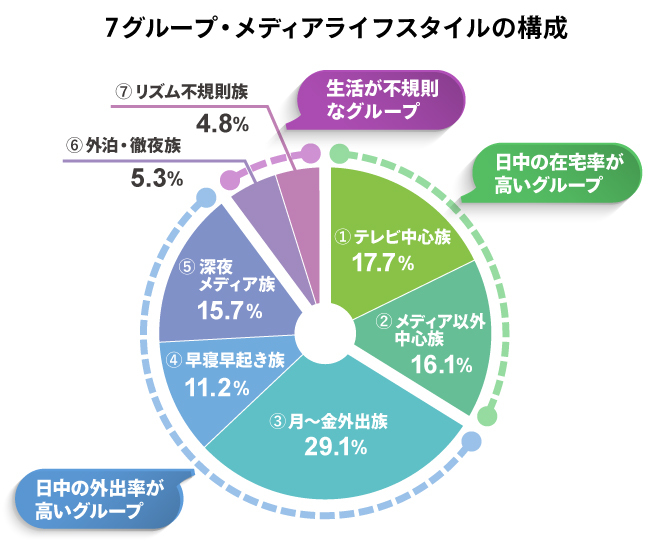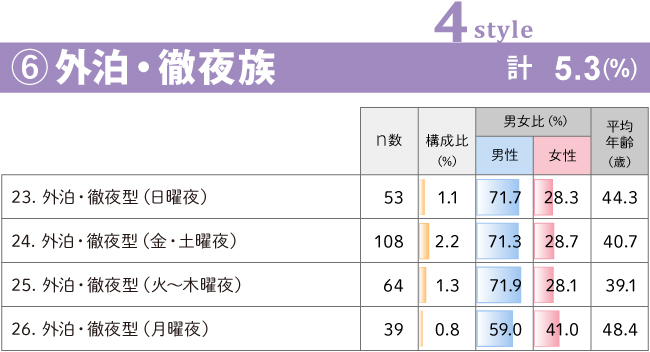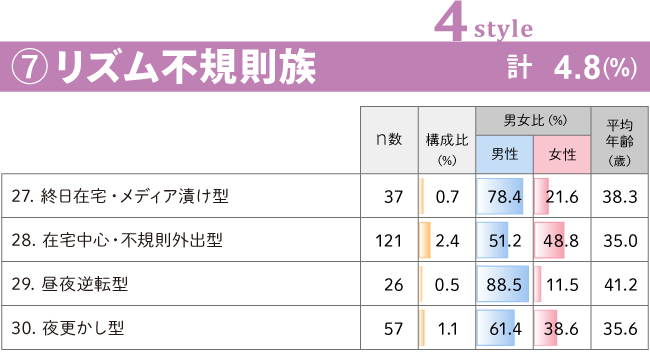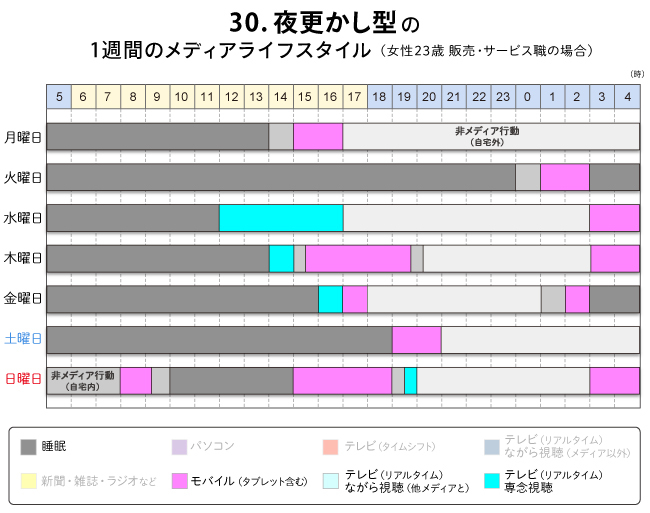This column introduces the results of a study on contemporary media lifestyles conducted jointly by Dentsu Inc. Media Innovation Lab and Video Research Ltd.'s Human Research Institute. So far, we have explained 30 media lifestyles across 7 groups in three installments. This time, we will explain 8 media lifestyles included in the two groups with irregular lifestyles: "⑥ Overnight Stayers & All-Nighters" and "⑦ Irregular Rhythm Group".
First, a brief explanation of the terminology used is necessary. The phrase "irregular lifestyle" might easily conjure unhealthy connotations, but in this context, it simply refers to having at least one day per week that does not fit the typical daily rhythm of waking in the morning, being active during the day, and sleeping at night.
Furthermore, "sleeping out" does not necessarily mean spending the night and sleeping away from home, and "staying up all night" includes cases where individuals are simply engaging in activities originally intended for nighttime as scheduled.
In this sense, the two groups introduced here—"⑥ Overnight Stayers & All-Nighters" and "⑦ Irregular Rhythm Group"—represent distinct lifestyle "types." Combined, they account for nearly 10% (10.1%) of the population. Considering that 90% of people belong to one of the media lifestyles introduced over the past two installments, if told that roughly one in ten family members or acquaintances might have such a lifestyle, it might strike them as a surprisingly large share.
Within these groups, the "⑥ Overnight Stayers/All-Nighters" have one to several days per week that don't fit a typical rhythm, while the other group, the "⑦ Irregular Rhythm Group," maintains a non-typical rhythm throughout the entire week.
Let's start by introducing the "⑥ Sleep-Out/All-Nighter Tribe."
The Four Styles of "Overnight Stayers/All-Nighters"
The four styles of the "⑥ Overnight Stayers/All-Nighters" share the commonality of having several nights a week when they do not return home, but the specific days of the week differ for each style.
The "Overnight Absence/All-Nighters" group is primarily composed of working individuals, especially men. In this respect, it shares similarities with the group we introduced last time that has a high daytime absence rate.
Among these, the "24. Overnight Stay/All-Nighter Type (Friday/Saturday Nights)" may be most relatable to young, single, urban-dwelling salarymen. Individuals who spend Friday nights drinking all night with work colleagues and Saturday nights with friends from their student days, returning home on the first train in the early morning, often fit this style (though workers with night shifts on Friday or Saturday nights also frequently fall into this category).
This time, let's shift our focus slightly and examine the weekly media lifestyle of those in "23. Overnight Stay & All-Nighter Type (Sunday Night)".
The shift-based lifestyle found among "23. Overnight Stay/All-Nighter Type (Sunday Night)"
A defining characteristic of the "23. Overnight Stay/All-Nighter Type (Sunday Night)" group is that the dark gray peak (sleep) typically appearing on Sunday nights at the far right of the graph is only visible for about 30% of them. This means a full 70% are awake and active outside their homes.
Conversely, the graph's left end shows a clear gray area at 5 AM on Monday.
This indicates that this pattern does not necessarily mean they are active outside the home every Sunday night, but rather that "during the survey week specifically," they were outside the home on the last Sunday. Furthermore, this pattern shows that in addition to Sunday nights, a significant number of people are also out on Wednesday and Saturday nights.
Regarding media consumption patterns, during hours spent at home, they engage with diverse media and devices, primarily TV, along with PCs and mobile devices. On Wednesday and Sunday nights, they also have the means to watch TV while out.
What's interesting is that the red-shaded portion (time-shifted TV viewing) stands out relatively prominently within the time spent at home. This likely indicates that even with irregular lifestyles where they can't always rest at home on the same day each week, they've developed the habit of recording their favorite regular programs to ensure they don't miss them.
Let's examine the media lifestyle of one individual from this pattern over a week.
Here is the weekly media lifestyle of a 27-year-old woman working in sales and services.
On Monday, she takes a nap starting around 1 PM for about two hours. From Tuesday night through Wednesday afternoon, she has a long period of sleep. After that, she leaves home before 4 PM and doesn't return until just before 10 AM the next day. She then sleeps again from the afternoon into the evening. On Sunday, she sleeps from the morning until past noon, followed by an outing lasting until the following Monday.
Given she works and spends about two nights a week away from home from midnight until morning, she is likely a shift worker, such as a nurse.
Reflecting characteristics of the younger generation, this person shows frequent mobile device usage both at home and outside. Television viewing is limited to live broadcasts, with dedicated viewing during prime time on days when they are home in the evening. Thus, while television broadcasts are influenced by irregular daily schedules, they also seem to possess the power to create rhythms in daily life through programming schedules.
The Four Styles of the "Irregular Rhythm Tribe"
We've introduced seven distinct media lifestyle groups over three installments. Finally, let's examine the characteristics of "⑦ Irregular Rhythm Group."
The four styles within the "Irregular Rhythm Group" each exhibit distinct forms of irregularity. While we will detail "30. Night Owl Type" later, the other three styles also display notable characteristics, which we briefly introduce here.
"27. Full-Day Homebound Media Immersion Type" spends almost the entire week at home, rarely going out. This group is overwhelmingly male, with the largest proportion (32.4%) being unemployed individuals who are neither students nor full-time homemakers. Professionals and freelancers also make up over 20% (21.6%) of this group, the highest proportion among the 30 styles. They spend most of their time at home with specific media (overwhelmingly PC internet use, but also dedicated real-time TV viewing or dedicated radio listening). Notably, their daily PC internet video viewing time is 99.0 minutes, the longest among all styles.
The "28. Home-Centered, Irregular Outings" type typically sleeps until around 8:00 AM and spends most of the morning at home. Many stay awake until before 2:00 AM. This type has a younger average age and a higher proportion of women, with housewives (24.0%) and university students (19.8%) making up a large share. A key media usage characteristic is spending an average of 78 minutes per day playing games (including mobile games), primarily using game consoles or PC games during the day.
"29. Day-Night Reversal Type" individuals stand out for literally living with reversed day and night schedules throughout the week. Among all 30 styles, this group has the highest proportion of males at 88.5%. Looking at occupational composition, 57.7% are engaged in manual labor or operational jobs like security or late-night civil engineering work, also the highest among all 30 styles.
So, how does "30. Night Owl Type" differ from these three styles as an "irregular" type? Let's examine its characteristics.
The primary representatives of "30. Night Owl Type" are sales and service workers centered on nighttime operations.
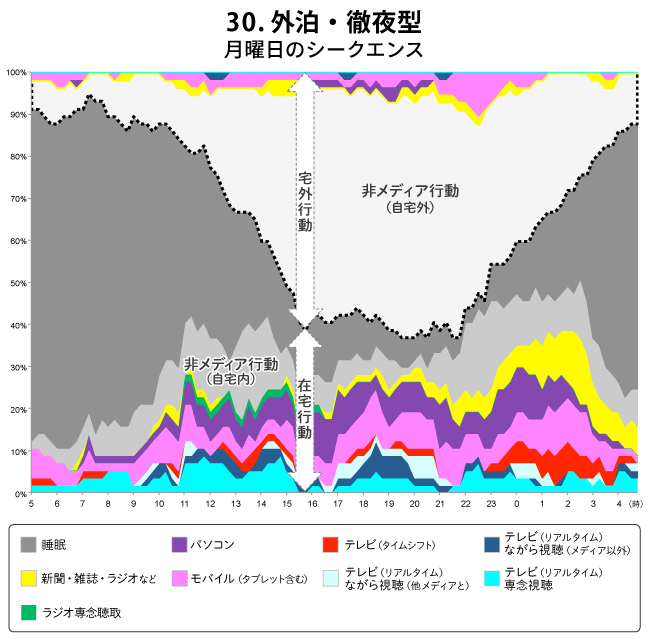
For the "30. Night Owl" type, over 40% are still out of the house at midnight on weekdays, and around 10% are still out at 5 AM, leading a lifestyle centered around sleeping during the morning hours.
The average age is young (35.6 years), and the female ratio is also significant at 38.6%. Notably, the proportion of "sales and service workers" is exceptionally high, reaching 36.8%—the highest among all 30 styles. This suggests people leading urban lifestyles, such as those working in nighttime-operated restaurants, fit this style.
Key characteristics of this group's media consumption include high dependence on mobile devices. Specifically, their daily usage of mobile web/email at home (71.2 minutes) and mobile games (35.6 minutes) is the highest among all 30 lifestyles.
Let's examine the weekly media lifestyle of one individual from this style.
Here is the weekly media lifestyle of a 23-year-old woman working in sales and services.
Regardless of weekday or weekend, her activities outside the home primarily occur after 5:00 PM, suggesting her work likely extends into the late evening. While her schedule isn't a complete reversal of day and night, her sleep time falls between 5:00 AM and past noon.
While dedicated TV viewing appears sporadically, the significant duration of mobile use at home before leaving and after returning indicates that the rhythm of her media lifestyle is largely shaped by information gathering, communication, and entertainment on mobile devices.
Focusing on the Future of Non-Traditional Lifestyles
This time, we've detailed two groups with "irregular lifestyles." We confirmed that even among these non-traditional groups, a media lifestyle positioning TV and mobile as primary information sources is widespread.
These two groups are thought to represent segments whose proportion has significantly increased since the 1980s, influenced by the advancement of urban living and the 24-hour availability of media access. Currently, they account for 10% of residents in the Kanto region (within a 50-kilometer radius of Tokyo Station). Points of interest include whether this share exists similarly in other major cities and whether it will expand in the future. Conversely, it is also noteworthy whether it might decrease due to factors like the progression of aging, the introduction of policies and systems such as work-style reforms, or shifts in values.
This concludes the detailed introduction of the seven groups and 30 media lifestyles identified in this study.
In the fifth and final installment of this series, we will summarize our reflections based on these findings and outline future prospects.

